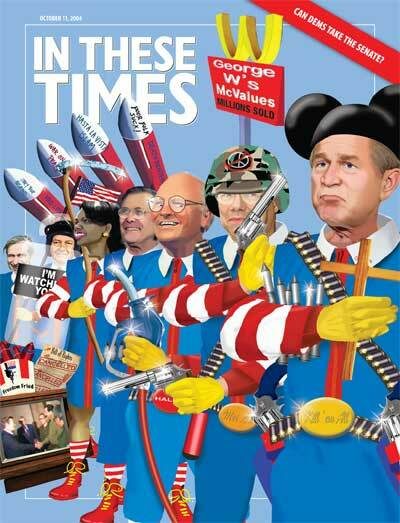
Seems simple now: Observe as a cabal of Christian billionaires cadges an election and takes over the country, waging war and short-sheeting the citizenry. Put to-gether a nonfiction movie about it. Make $120 million.
And Fahrenheit 9/11 hasn’t even hit home video, pay-per-view or cable yet. Michael Moore may have benefited from the Bush administration just as that tribe of Reagan-era scrapings has benefited from 9/11, but because of his unprecedented success (for a documentary, and certainly in terms of cost-to-profit ratio), suddenly the American movie theater has become an energized locus of political activism.
Political documentaries are nothing new — produced by the penniless faithful, the films generally have headed for regional film festivals, late-night PBS or, commonly, nowhere at all. Now, thanks to Moore, the nation’s urban screens are chockablock with radical anger. As I write, 12 nonfiction dissenting acts of intervention are playing in New York (including Moore’s hit, holding for more than two months, and Control Room, for more than three-and-a-half) — 12 docs, playing simultaneously in one city in the summer, all of them focused furiously on the political present.
Up to eight more films have come and gone and are now hopscotching their way west through the major cities. New films are being unearthed, slapped together or coaxed out of their caves every week; in the last weeks of August, we’ve been treated to Bush’s Brain (a profile on Karl Rove), Persons of Interest (about Patriot Act detentions), Hijacking Catastrophe (a brisk primer on the whole shebang) and Outfoxed (et tu, Rupert Murdoch?).
Compare this to just a year ago, or 10 years ago, or 20. The absolute last place any of us would expect to find vital political intercourse would be the multiplex; in roughly the 27 years since Star Wars, American movies have become so uniformly odious, childish, bombastic and pandering that the notion of social engagement was something you necessarily left, with your cerebral cortex, at the door. Ordinarily profitable in nickels if at all, documentaries have occupied such a low rung on the ladder that they’re barely recognized as film product at all, but rather the indulgent passion of wacko hobbyists barely rescued from the jaws of poverty by increasingly modest NEA checks. Now, thanks to Moore (and Bush), documentaries are cool and profitable as they’ve never been, not even in the ’60s heyday of the cinéma vérité movement and the Maysles brothers. Never before has there been a paying doc audience of 17 million or so as there has been for Fahrenheit, and so distributors and exhibitors are scrambling to cut a slice of it for themselves.
But there’s another, unintentional integer in the equation: Let us not overlook the essential strangeness of having this popular upsurge in radical cinema peak during Hollywood’s prize tourist season, when we are not supposed to think. It has been the most bizarre summer the industry has ever seen — more so, even than the glorious dog days of 1999, when money-burning behemoths like The Haunting were taken for a nine-figure ride in a little wooden go-cart called The Blair Witch Project. Today, we have a case of cosmic synchronicity — at the same time Bush & Co. are giving pro-am moviemakers all the reason in the world to unbox their digital cameras and document their rage, Hollywood falls on its royal ass. A large majority of the films that were supposed to be dominating our brainwaves from May to September tanked: Spending more than Moore’s net on production costs alone, Around the World in 80 Days earned back one-fifth of that domestically before evaporating. The Terminal, Collateral and Alien vs. Predator didn’t break even (taking post-production and advertising costs into consideration, as one should). Catwoman, The Stepford Wives and King Arthur failed to reap half of what they cost. Big-budget failures out-numbered the winners three to one, ceding screens to indies (Garden State and Napoleon Dynamite were the luckiest of many benefactors) and documentaries, including Fahrenheit 9/11.
Rationalize it however you want, but even the most embittered cynics among us must reflect cheerfully upon the cultural moment when moviegoers chose not the $120 million Jackie Chan idiocy but a dissenting melange of news footage and talking heads instead. As a few studio suits hit the bricks, we can sit back and consider that, maybe, there’s hope for us media consumers after all.

I hope you found this article important. Before you leave, I want to ask you to consider supporting our work with a donation. In These Times needs readers like you to help sustain our mission. We don’t depend on—or want—corporate advertising or deep-pocketed billionaires to fund our journalism. We’re supported by you, the reader, so we can focus on covering the issues that matter most to the progressive movement without fear or compromise.
Our work isn’t hidden behind a paywall because of people like you who support our journalism. We want to keep it that way. If you value the work we do and the movements we cover, please consider donating to In These Times.








